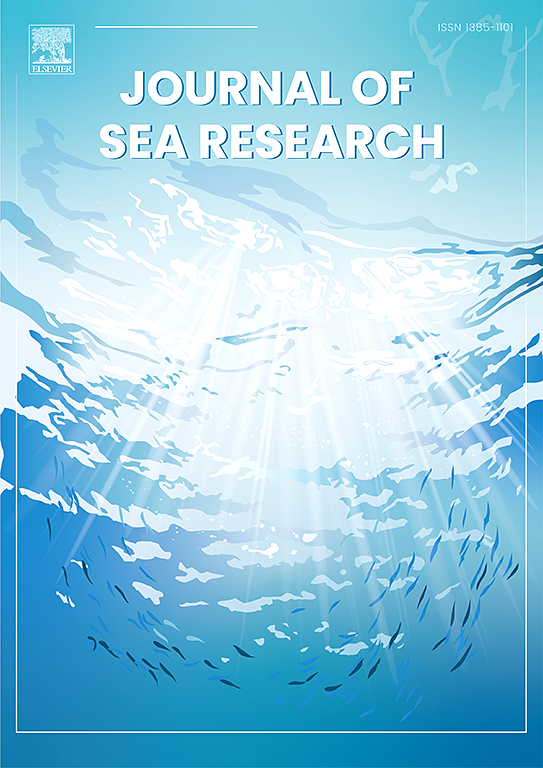Generating ecologically relevant oxygen fluctuations using marine primary producers under laboratory conditions
IF 2.9
4区 地球科学
Q2 MARINE & FRESHWATER BIOLOGY
引用次数: 0
Abstract
Incorporating near-natural variation of marine environmental variables into experimental designs is becoming imperative to make ecologically relevant inferences about ecophysiological responses to climate global change. Dissolved Oxygen (DO) is among the most important environmental variable in marine ecosystems and fluctuates strongly in coastal habitats, due to physical and biological phenomena. However, many technical challenges are still imposing high-cost equipment to ensure a complete mimicry of DO fluctuations in manipulative experiments. Here, we propose a simple and cost-effective methodology to simulate the oxygen fluctuations in the laboratory through to marine primary producers as source of natural fluctuations. We tested the physiological status (Yield II and Fv/fm) as a proxy of oxygen evolution, and photoprotective responses (phenolic production), as metabolic stress indicator in five different biomasses (200–400–600-800-1000 g; that correspond to 6–12–18-24-30 g l−1, respectively) of the macroalgae Lessonia spicata exposed to 7 days of artificial light (photoperiod of 12:12 h day: night) within replicated aquaria. We showed that each biomass exhibited a unique fully functional oxygen fluctuating profile with different average DO saturations, harmonic oscillations and rates of DO production/consumption. Biomasses <600 g showed no significant changes in the physiological status of macroalgae (Yield II and Fv/fm) and photoprotective responses (phenolic production) during the 7 days experiment, while effects of the environmental stress were found at greater biomasses (800 and 1000 g). We successfully tested a method that can produce daily cycles of DO fluctuations in seawater trough to marine primary producers under controlled environment conditions. Our quantitative method provides cost-effective control the DO fluctuations in experimental set-ups with the use of a primary producers that can be replicated at low cost in virtually any laboratory worldwide using other species of marine algae, representing a highly effective method to control experimental settings that involve testing of fluctuating and ecologically relevant levels of dissolved oxygen.
在实验室条件下利用海洋初级生产者产生生态相关的氧波动
将海洋环境变量的近自然变化纳入实验设计中,对气候全球变化的生态生理反应做出与生态相关的推断变得势在必行。溶解氧(DO)是海洋生态系统中最重要的环境变量之一,由于物理和生物现象,在沿海生境中波动剧烈。然而,许多技术挑战仍然强加高成本的设备,以确保在操作实验中完全模仿DO波动。在这里,我们提出了一种简单而具有成本效益的方法来模拟实验室中的氧气波动,通过海洋初级生产者作为自然波动的来源。我们测试了5种不同生物量(200-400-600-800-1000 g;(分别对应于6-12-18-24-30 g l−1),即在复制水族箱内暴露于7天的人工光照(光周期为昼夜12:12 h)。我们发现,每种生物量都表现出独特的全功能氧波动曲线,具有不同的平均DO饱和度、谐波振荡和DO生产/消耗速率。在7天的试验中,600 g生物量对大型藻类的生理状态(产量II和Fv/fm)和光保护反应(酚生成)没有显著影响,而在更大生物量(800和1000 g)中发现了环境胁迫的影响。我们成功地测试了一种方法,该方法可以在受控环境条件下向海洋初级生产者产生海水槽中DO波动的每日循环。我们的定量方法提供了成本效益高的控制实验设置中溶解氧波动的方法,使用初级生产者,可以在世界上几乎任何实验室使用其他种类的海洋藻类以低成本复制,这是一种非常有效的方法,可以控制涉及测试波动和生态相关溶解氧水平的实验设置。
本文章由计算机程序翻译,如有差异,请以英文原文为准。
求助全文
约1分钟内获得全文
求助全文
来源期刊

Journal of Sea Research
地学-海洋学
CiteScore
3.20
自引率
5.00%
发文量
86
审稿时长
6-12 weeks
期刊介绍:
The Journal of Sea Research is an international and multidisciplinary periodical on marine research, with an emphasis on the functioning of marine ecosystems in coastal and shelf seas, including intertidal, estuarine and brackish environments. As several subdisciplines add to this aim, manuscripts are welcome from the fields of marine biology, marine chemistry, marine sedimentology and physical oceanography, provided they add to the understanding of ecosystem processes.
 求助内容:
求助内容: 应助结果提醒方式:
应助结果提醒方式:


